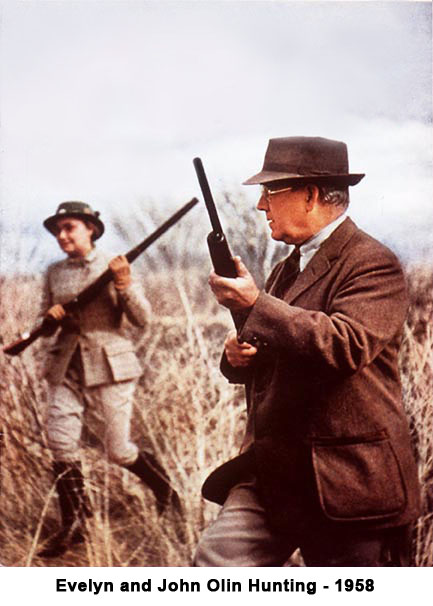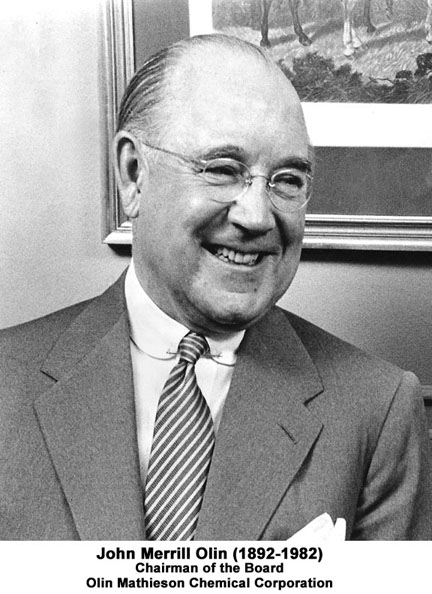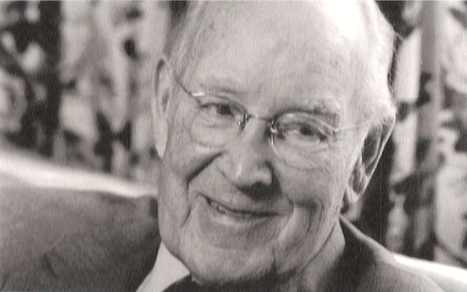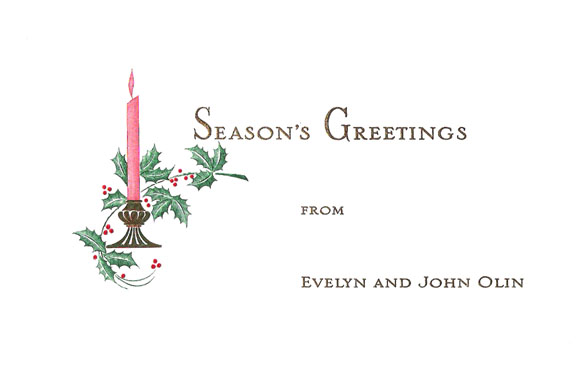|
|
|
A Tribute to John Merrill Olin |
||||||||||||||
 |
||||||||||||||
 |
||||||||||||||
|
To 40,000 employees in the many and varied Olin enterprises (Olin Mathieson Chemical Corporation, Winchester-Western arms and ammunition, Squibb drugs, Ecusta paper, Olin cellophane and aluminum, etc.) scattered across the nation, 66-year-old John Merrill Olin is the boss. To the 10-year-old black Labrador named King Buck, whose portrait hangs behind Mr. Olin in the picture at left, he may be the boss sometimes, but more often than not he is just a good-natured pushover on whose bed King Buck likes to sleep, regally aware that no mere captain of industry would tamper with the comfort of one of the greatest field-trial champions in the history of the Labrador retriever breed. Such inversions of authority do not happen often in John Olin's well-organized world. But at Nilo Kennels (Olin spelled backwards) near Alton, Illinois, where some of the finest Labrador retrievers in America are raised and trained, King Buck rules unchallenged and Olin is the first to admit it. He is proud of King Buck, who is a personal project of his, and for that matter he is probably prouder of his kennels and of adjacent Nilo Farms, a sprawling, game-rich, 522-acre shooting preserve, than of any other part of his considerable empire. This is the place where John Olin would rather spend his time than anywhere else in the world. From fall to spring on many a day he can be found roaming through the lush acreage after pheasants or crouched in a blind waiting for flighted mallards to come winging overhead. In between, he works his dogs, readying himself and them for the dozens of field trials which are his favorite hobby. Often his attractive wife, Evelyn, a sportswoman in her own right, comes along, despite the fact that her enthusiasms rest more with bird hunting and salmon fishing than with field-trialing. "She really can't stand field trials," Olin chuckles, "and she doesn't mind letting me know it. As far as Evelyn is concerned, field-trial enthusiasts are insane, because they get up before daybreak, jump in the car and sometimes drive over 100 miles of almost impassable roads to stand out in the rain, sleet, snow and freezing weather to watch an expensive dog someone spent a fortune to raise and train make stupid mistakes." Even so, Evelyn Olin has gone along on many of her husband's outdoor jaunts. Though she most favors the relaxed life of their Nilo Plantation near Albany, Georgia, with its leisurely afternoon quail hunting, she likes to go with him for salmon on the Restigouche, ducks in Stuttgart, Arkansas, partridge in Spain and chamois in Austria. She draws the line at bear hunts in Alaska, though, or Olin's annual deer and antelope hunts in Wyoming. "She just doesn't like anything that starts before daybreak," Olin says fondly. "I've been getting up before daybreak since I was a boy, and it's just become the natural way to start a day. "Of course," he adds, "at that time I was getting up to milk the cows and do the chores." The cows and the chores were on a farm owned by John Olin's uncle, Amos Merrill, at the foot of Mount Moosilauke near Warren, New Hampshire. Every summer of his boyhood, Olin spent his vacation with his uncle on the farm, helping with the crops and livestock and learning about the outdoors. "I've often tried to analyze what happened to me to make me love the outdoors so much," Olin says. "Whatever it was, it happened there. Uncle Amos had twin daughters but no sons. I guess I filled a void for him, and he certainly filled one for me. He gave me my first gun and taught me how to shoot it. We'd go out together and run the bear traps, or hunt wood-chucks or wade the trout streams near the farm. "And I also learned something else that was important," Olin adds. "I learned the psychology of a Yankee. Uncle Amos taught me all the facts of life, and then some. I learned to work there, and to save my earnings. My uncle paid me 15¢ an hour to dig kale out of the corn, and if I didn't work I didn't get paid. "When I finally accumulated $15, I bought my first fly rod. That was the summer I was 7. By the end of that summer I knew where every trout in every pool was, and I could jump from rock to rock like a cat." It was during this same summer that Olin had his first brush with what he termed "commercialism in sport." One day he was taking eight good fish back to the farm when he met a man with the best fishing outfit he had ever seen. "I was green with envy," he remembers. "It was funny, because he was just as envious of me. He hadn't caught a fish on all that fine tackle. He wanted to know where I'd caught mine. I pointed to a pool and said, 'There's one right over there.' In three casts I had it. The man was really dumfounded. Then he offered to buy my fish. I took one more long look at his beautiful fishing outfit and thought of all that kale in the corn. But finally I said no thanks, I'd give him the fish." Along with his knowledge of the outdoors, young Olin, with the same thoroughness, also set about learning all there was to know about his father's explosives business, which even as a small boy he knew would be his life's work. By the age of 16 he was ready for Cornell University, where he mapped out a prodigious chemical engineering program. From Cornell, in 1913, he went directly into his father's company, then Western Cartridge, in East Alton, Illinois, the first trained scientist to be employed by the organization. From the beginning, Olin applied his practical outdoor experience to his technical training. Every time he went on a hunt, he went with more in mind than sport alone. He personally tested all the new cartridges and shells produced by his company, digging out bullets for laboratory analysis, studying new methods, refusing to accept old ones just because they were in practice. His inquisitive, inventive mind looked steadily into the future, and many of the corporation's new products were his own personal developments. Currently he holds 22 United States patents on them. The best known of these, his Super-X shotgun shell, grew directly from a hunting experience. Back in the '20s, Olin was waterfowl-hunting one day with a friend who preferred shooting ducks on water rather than in flight. This violation of the ethics of good sportsmanship so outraged Olin that he not only refused to fire a shot but decided to do something positive to prevent his friend from repeating the performance. In his laboratory, Olin mulled over the problem of increasing velocity, and thus getting greater range from a shell, without increasing pressure in the gun chamber to a dangerous level in the process. By developing pressure over a longer period of time (thereby creating a more satisfactory pressure-velocity relationship) through the use of a progressive-burning smokeless powder, Olin came up with a unique "short shot string" shell which had an extended range of more than 20 yards over that of conventional loads. This development was so radical—and so successful—that Olin called it "super excellent." An associate suggested dropping the "excellent" and calling it simply Super-X. Armed with a box of Super-X shells, Olin thereupon invited his friend again to do some waterfowl shooting. And every time a duck hove into sight high over the blind, Olin was able to knock it down yards before it dropped in range of his companion's conventional loads. The subsequent popularity of Super-X rocketed Western to the front ranks of U.S. shell manufacturers. But perhaps Olin's greatest invention, and certainly his proudest, is one on which he holds no patents. This is Nilo Kennels and Farms, the pilot project in 1951 of a vast national experiment in conservation. Like other Olin inventions, this too grew out of his love of the outdoors and his practical view of the future. A PRACTICAL DEMONSTRATION As a sportsman and a shell manufacturer Olin was constantly concerned with the long-range effect of the tremendous postwar hunting boom on an already shrinking outdoors. He was afraid that unless constructive measures were taken right away places to hunt in America would eventually vanish completely. One solution, he believed, was the widespread education of hunters to the conservation value of trained dogs in recovering lost and crippled game. Another was the replenishment of wildlife through artificial stocking and scientific improvement of habitat conditions. Olin decided that both of these ideas needed more practical demonstration than they were currently getting. First he set about developing the finest retrievers in the country to demonstrate at their kennels and at field trials the importance of using trained dogs in hunting. In January 1951 he hired T. W. (Cotton) Per-shall, a young professional dog trainer and handler who was making a reputation for himself on the field-trial circuit. Pershall, his wife and his two Labrador retrievers moved into an old farmhouse on 552 acres of partially farmed Olin-owned land near Alton, 13 miles from the Olin plant at East Alton. Plans were mapped out for the construction of Nilo Kennels and the rehabilitation of the land as a wildlife preserve on which Olin could prove the value of stocking wildlife and improving natural habitat. By May the project was under way, and John Olin decided to buy himself a field-trial dog. For over a year he had been studying the competitive performances of young retrievers on the circuit and latterly he had been particularly following the progress of a 3-year-old black Labrador named King Buck, who was winning more than his share of trials. Although he had not actually seen Buck run, Olin decided that this was the dog for him. Pershall, with years of field-trial experience behind him, thought differently, and didn't hesitate to express his objections. King Buck's early history was bad. His bloodlines were good but he was the product of a very disappointing litter. His owner had purchased him as a pup for $50 and nursed him through an extended siege of distemper, during which he was advised twice to destroy him. When Buck finally regained his health, his owner couldn't afford to train or campaign him. Eventually the dog was sold to Bing Grunwald of Omaha, who established him on the competitive circuit. A month after his third birthday, Buck earned his field-trial championship. He looked good, but in Pershall's professional judgment he didn't look good enough to warrant the $6,500 selling price Grunwald was now asking. Besides, Pershall had a much better (and less expensive) prospect lined up—a Labrador named Freehaven Muscles, who not only showed great future promise but boasted a more stable background. Cotton Pershall was still new at Nilo, which may be the reason he didn't know just how stubborn John Olin can be. Freehaven Muscles, Olin agreed, certainly looked like a fine prospect. Cotton was right in wanting him for Nilo Kennels, and should lose no time in acquiring him. In the meantime, however, Olin was going to buy King Buck, and that was the end of that. Although Cotton handled and trained both dogs, Buck became known around the kennels as John Olin's dog and Muscles as Cotton Pershall's dog. A year after his purchase, Muscles earned his championship and went on to justify the confidence Pershall had placed in him. But John Olin's dog did better; he made field-trial history. In November 1952 at Weldon Springs, Missouri, under Cotton's expert handling, King Buck romped off with the National Retriever Field Trial Championship, the most coveted prize in retriever competition. The following year he came back to repeat his victory, only the third dog to do so in the history of the event. In the 82 national field-trial series in which he participated during his competitive career, King Buck completed 80 consecutive series, a record no dog has ever approached. But some of the other Nilo dogs, including King Buck's sons and grandsons, have given him stiff competition. In the seven years since its beginning, Nilo Kennels has produced seven other field-trial champions under Cotton Pershall's expert handling and training. Olin, studying Pershall's methods and techniques, personally guided four of these dogs to amateur field-trial championships in competitions where professional handlers are not eligible. There are currently 63 dogs at Nilo: 44 black Labradors (including King Buck, who is now retired), eight yellow Labradors, two beagles, two Brittany spaniels, one English setter, three English springer spaniels, two pointers and one Weimaraner. Six of these dogs were gifts to the kennels, but all of the rest were either bred at Nilo or purchased by John Olin to improve breeding lines. He has worked particularly with Labradors—studying the history and performance of various bloodlines and importing English stock, including an English National Champion, to get away from the tight little circle of breeding in this country. There has been only one major setback at Nilo, which occurred shortly after it was started. An epidemic of distemper swept through the kennels, destroying much of the stock. To prevent such a disaster from striking again, Olin built an isolation kennel modeled on medical findings at Cornell. Set apart from the other kennels, it is run as scientifically and antiseptically as a fine hospital. In order to enter the "medical wards" inside, a visitor must first pass through a special room where he must strip, shower and put on the sterile white clothing of a surgeon about to operate. All new dogs are quarantined in the isolation kennel for a specific period of time, during which they are carefully examined, observed and tested for possible disease. Whelping also takes place here, and new-born litters remain until they outgrow the infection period. In addition, all Nilo dogs receive blood tests twice yearly under a preventive-medicine program which has proved, among other things, that dogs inoculated against distemper (formerly believed an inoculation of lifetime immunity) are not necessarily protected forever from the disease. While Nilo Kennels was becoming the best-managed Labrador breeding and training center in the country, the adjacent land called Nilo Farms was becoming the best-managed game preserve. At about the same time Pershall came to Nilo, Olin Industries hired a staff of trained conservationists, and the 522 acres of rolling farmland near Alton were converted into rich game-bird cover, heavily planted with alfalfa, wheat, soy beans, lespedeza, sweet clover and corn to create a balanced system of crop rotation. Food patches of sorghum and millet, which provide additional cover as well as food, were spotted every four or five acres. Timber and shrubs were planted in scattered clumps to cut down soil erosion and serve as gathering points for pheasants after a shoot. THE CRUSADE BEGINS As soon as suitable habitat was established, the land was stocked with pheasants and mallard ducks and, for experimental study, with a variety of semi-exotic birds like Coturnix quail and chukar partridge. Then Nilo Farms was ready to carry out John Olin's most cherished crusade: the education of sportsmen and game-management agencies to the potentials of wildlife preserves in a diminishing outdoors—a concept which had few supporters in the '40s and early '50s. The job was not an easy one. Hunters in general were reluctant to try preserve shooting because they believed it artificial. Game departments looked with little enthusiasm on the additional supervision and enforcement that would be expected of them and with suspicion on the actual benefits to wildlife which might ensue. When Olin invited representatives of both groups to visit Nilo and see how the operation worked, they came, but with misgivings. They left with an education. Under Nilo Farms' staff, they were instructed in planting and planning of habitat, in scientific principles of rearing and harvesting game birds, in the long-range benefits to the surrounding country which artificial propagation of wildlife would ultimately reap, and in the value of trained hunting dogs to conservation. Olin, meanwhile, propagated the faith in other ways. He stomped across the country, cornering any and all who would listen to his cause. At field trials he sloshed through mud and rain to hand out literature on preserve shooting. When he found an interested sportsman he enlisted him in the crusade; when he found one in doubt he refused to stop talking until the doubts had vanished. On business trips he would suddenly disappear to address a conservation or sportsmen's club on the role of preserve shooting in modern conservation. He was never too busy to speak to one more game official, one more sports reporter or one more man in the field. More and more his exhortations fell on receptive ears. The number of private and public preserves grew steadily across the country. This season there are 1,207 shooting preserves operating in 38 states, an increase of 451 since 1954. In 13 of these states, the game departments have regular instructional programs patterned after the program at Nilo Farms, which itself has expanded considerably since the 1954 merger of Olin Industries into the Olin Mathieson Chemical Corporation. The most recent area to join the booming preserve movement is Hawaii. When game department officials in the territory sent word of their interest to Nilo this summer, one of the Farms' conservation experts hopped the next plane west. In a week he had scoured the islands, studied the native wildlife and mapped out a preserve plan for Hawaii. Olin's conservation ideas are so effective that they have been applied even beyond the boundaries of preserve shooting. States like Georgia, long famous as one of the finest quail-shooting regions in America, have been shown that by bulldozing large growths of live oaks (which, once upended, provide excellent game-bird cover and protection during the three years or so they take to rot), then scientifically planting these areas with natural foods, they could sizably increase basic quail populations in spite of hunting pressure which had tripled in that many years. Thus, in less than a decade, Olin has seen the value of his belief in better dogs and better hunting dramatically proved and accepted. But he still has one outdoor ambition which as yet is unrealized. He has never hunted in Africa. Aside from the-sport itself, he has a typically Olinesque reason for wanting to make this trip. In the old days," Olin recalls, "I had two ways to prove a new bullet. I tested it in the laboratory. Then I went out and hunted with it. If it worked in both places, I knew I had a good bullet. "Now we have a new bullet, the .458. I know it's good because after we worked it over thoroughly in the lab I put it in the hands of people going to Africa, had them chop it out of all kinds of game and send it back to me. But I still haven't used it over there myself, and one of these days I want to. I've been around too long to start taking secondhand information on these things now." |
||||||||||||||
 |
||||||||||||||
|
John Merrill Olin by |
||||||||||||||
|
The Story of King Buck - National Grand Champion Field Trial Retriever |
||||||||||||||
 |
||||||||||||||